 Division Officer Training
Division Officer Training  Division Officer Training
Division Officer Training INFORMATION SHEET
SHIP'S SILENCING PROGRAM
Information Sheet Number: 9.7
INTRODUCTION
Surface ship silencing, like damage control, is everyone's business. Our Navy has dedicated significant resources to build noise control features into USW capable ships (DD-963), as well as the new classes of destroyers and cruisers (DDG-51 & CG-47). Unwanted noise can severely limit a ship's overall USW capability, both active and passive. A lack of understanding or inattention on the part of ship's personnel can negate the effect of installed quiet ship features and the efforts of your USW team to detect a submarine.
REFERENCES
(a) CNSL/CNSPINST C9073.1A (Ship Silencing)
INFORMATION
A. SHIPBOARD QUIET SHIP PROCEDURES
1. Reduction of sonar self noise over the frequency range of passive capable sonar is one goal of the Navy Ship Silencing Program. The other goal is a maximum reduction in the ship's radiated noise to obtain the best possible counter-detection posture relative to enemy submarines. The Ship Silencing Program is promulgated by the Fleet Commanders via references (a) and (b). A ship's survival may depend on its ability to minimize shipborne radiated noise.
a. Step One - Establish a Shipboard Noise Control Team. The team will be headed by the Chief Engineer and will consist of, as a minimum, the USW Officer, department/division representatives, and any technical ratings required to carry out the internal monitoring surveys.
b. Step Two - Identify installed systems and equipment which contribute significantly to the amount of noise the ship generates.
c. Step Three - Learn how the installed noise control features on your ship contribute to silencing. The primary noise control features are Prairie/Masker and sound isolation devices. In particular, all machinery and piping incorporating sound isolation devices should be identified and noted. These devices form a major part of the Noise Control Team's internal monitoring program.
d. Step Four - Establish a monitoring program. This program consists essentially of periodic surveys of noise-isolated equipment and their isolation devices. By conducting these surveys, the Shipboard Noise Control Team can prevent degradation to the ship's acoustic signature. Monitoring should lead directly to deficiency correction.
The primary purpose of internal and external monitoring is the identification of noise-generating equipment requiring maintenance action. These maintenance actions include, but are not limited to, the repair of common deficiencies such as replacement of faulty isolation devices, replacement of failed bearings, and replacement of noisy valves. Where shipboard/IMA/shipyard maintenance action is not sufficient to correct noise offending equipment, COMNAVSEASYSCOM will develop SHIPALTs to replace or modify equipment identified as class offenders.
(1) INTERNAL MONITORING - consists of periodic surveys of noise isolated equipment and their mounting devices within the 3M system (i.e. Zone Inspections). COMNAVSEASYSCOM is responsible for providing a PMS package to support this phase of the program.
(2) EXTERNAL MONITORING - measures the ship's radiated noise signature and serves to alert the Shipboard Noise Control Team to signs of internal machinery problems. The ship's radiated noise signature is directly related to the condition of the ship's machinery. External monitoring is normally conducted on an acoustic range capable of measuring a ship's radiated noise signature under the surface ship acoustic trials program. Currently, surface force ships undergo acoustic trials upon completion of building, during post-overhaul and, where possible, prior to deployment.
e. Step Five - Develop a Quiet Ship Bill (QSB). This provides the ship optimum equipment line-up versus ship speed requirements. If the Shipboard Noise Control Team has done its job, the ship's noise signature can be further reduced by the judicious selection of operating equipment and speeds. Having established the optimum equipment lineup, further noise reduction is achieved through ensuring the cavitation-free operation of pumps and piping.
B. NOISE AND NOISE SOURCES
1. Noise Categories:
a. Ambient Noise. a combination of all noise originating in the ocean environment such as weather, biologics, and shipping.
b. Self-Noise. The background against which the sonar must detect and classify incoming target signals is made up of ocean ambient noise and noise which is generated by the ship and sonar system. That portion of the sonar background noise which is caused by own ship systems is self-noise.
c. Radiated Noise. Propulsion and auxiliary machinery within the ship generates structureborne noise. Some of this energy is transmitted through the ship's structure to the hull where it is transferred into the water. Ships can also radiate sonar energy in an effort to find submarines. Structureborne noise and sonar noise combine to form the underwater radiated signature of the ship. Radiated noise is the acoustic signal detected by passive sonars. Radiated noise, therefore, provides a means for enemy units to detect your ship and also interferes with the sonars of escort ships.
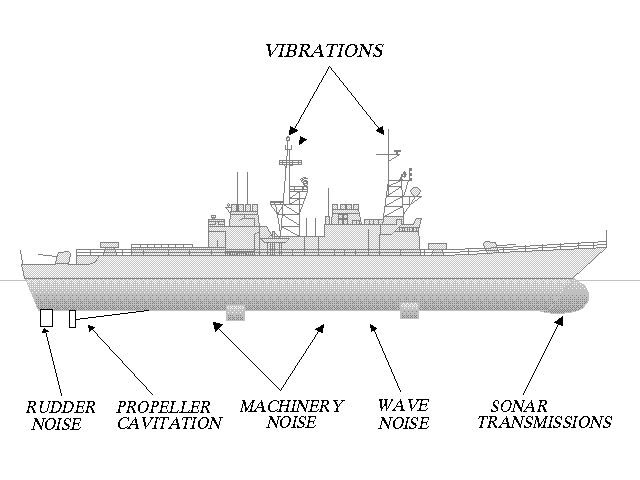
Figure 9.7-1 Radiated Noise
d. Self-noise is used when describing the effect a ship has on its own sonar. Radiated noise is used when describing the effect a ship has on off-board sensors.
2. Self-Noise Sources. Self-noise sources can be divided further into two additional categories: sonar noise and platform noise.
a. Sonar Noise. Sonar noise affects your own ship's sonar detection capability, and is discussed in Unit 7 as part of the sonar equation. Active sonar transmission signals are valuable aids for threat submarines in detecting, classifying and localizing your ship. Sonar transmissions are subject to emission control (EMCON) procedures. Since sonar noise is beyond the control of ship's force, it will not be discussed further. Control of sonar noise is NOT part of the shipboard noise control program, the purpose of the program is the control of platform noise.
b. Platform Noise. Platform noise is that noise generated by own ship other than the sonar system. Platform noise consists of radiated noise and crew generated noise. Control of this noise is the purpose of the shipboard noise control program. Platform noise is a primary concern when operating in EMCON.
3. Characteristics of Platform Noise Sources.
a. Machinery. Machinery noise originates as mechanical vibrations that are transmitted through the hull to the water, contributing to radiated noise. The vibration is also transmitted through the water and the ship's structure to own ship's sensor systems and becomes an element of self-noise. Machinery noise generates both broadband and narrowband noise.
b. Propeller Noise. Propeller noise originates outside the hull as a consequence of the propeller action and by virtue of the ship's movement through the water. The main source of propeller noise is cavitation noise caused by collapsing water vapor made by the rotating propeller blades. This noise begins above a certain speed, in the range of 9 to 15 knots, called the cavitation inception speed for ships with constant pitch propellers. For ships with variable pitch propellers, cavitation occurs at both low and high speeds; the cavitation free speeds will be in the vicinity of 12 knots, and this is usually the best speed regime for USW operations. Another important form of propeller noise is "singing" caused by propeller blade resonance. Singing generally occurs only within a narrow range of ship's speed.
c. Flow Noise (Hydrodynamic noise). External flow of water against the hull and internal flow of fluids through piping systems transmitted to the hull. External flow of water against the hull causes rattles and vibrations in hull plating and external structures. Other kinds of flow noise are the roar of the breaking bow and stern waves of a moving ship and turbulence produced by the sonar dome or towed array.
d. Electrical Noise. A source of sonar self-noise is the pickup of electrical signals from machinery and electronic equipment. This noise is called electromagnetic interference (EMI). A frequent source of EMI is arcing of brushes and motors. Electronic equipment cabinets that have high voltage switching will cause EMI unless properly grounded.
e. Miscellaneous noises:
(1) Shipboard maintenance (needle guns, scrapers).
(2) Special operations (flight ops, helicopter landing and take-off, UNREPS).
(3) Ship's force must be aware of these other noise sources when the Quiet Ship Bill is in effect.
4. Typical shipboard noise problems include sound shorts, rattles, flow tones and unauthorized transmissions.
5. Self noise is affected by shipboard operations. Self noise increases with ship speed, and will vary with the current engineering plant line-up and quiet ship operating condition in effect.
C. INSTALLED SHIPBOARD NOISE CONTROL FEATURES
1. Method of approach to controlling noise:
a. Control noise at the source (i.e. the equipment). Examples are the replacement of noisy machinery with quieter machinery, use of quiet valves for steam, hydraulics and seawater, and use of PRAIRIE air to mask propeller cavitation.
b. Control noise in the transmission path (i.e. decks and bulkheads). This can be accomplished by isolation using resilient mounts, Distributed Isolation Material (DIM) and flexible piping connections.
c. Control noise at the radiating surface (i.e. hull). Coating materials for the hull and masker air are the two methods used to acoustically isolate the hull from the water.
2. Three classes of Sound Isolation Devices:
a. Resilient Mounts - rubber shock devices used on machinery and piping.
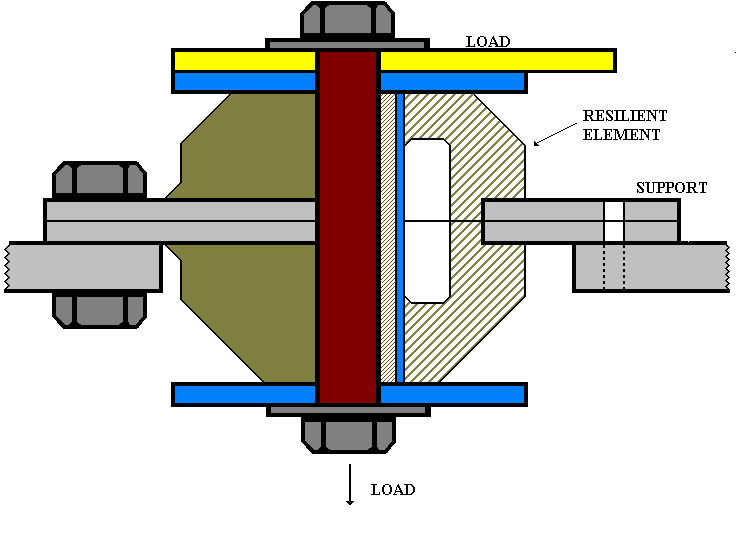
Figure 9.7-2 Typical Resilient Mount
b. Distributed Isolation Material (DIM) - rubber type pads used on smaller equipment.
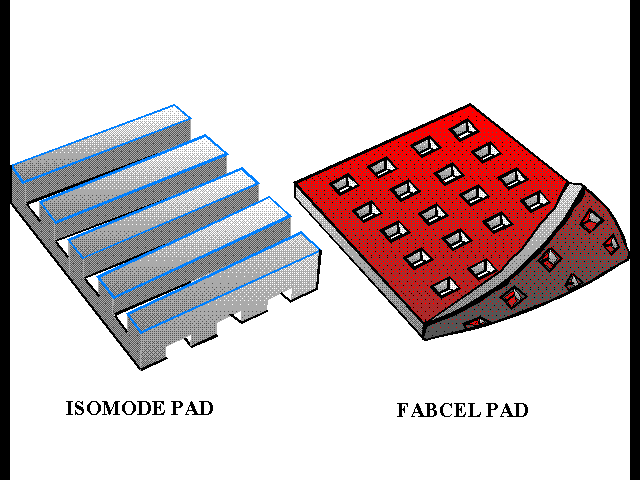
Figure 9.7-3 Distributed Isolation Material
c. Flexible Connections - used on pipes and hoses.
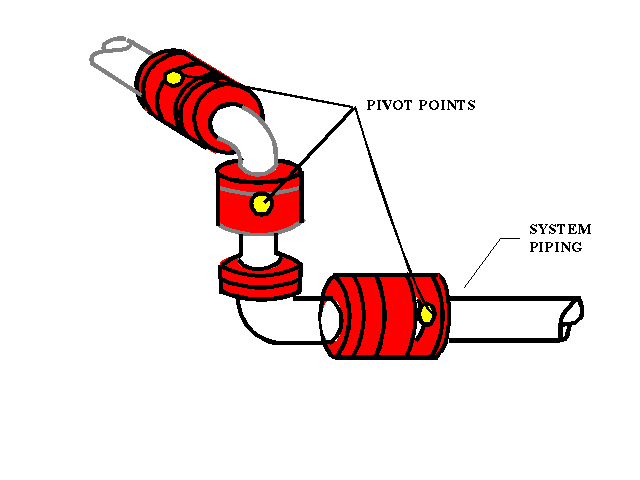
Figure 9.7-4 Flexible Connection
3. Sound isolation devices are most effective when properly matched to machine characteristics and when both the machine and device are properly maintained.
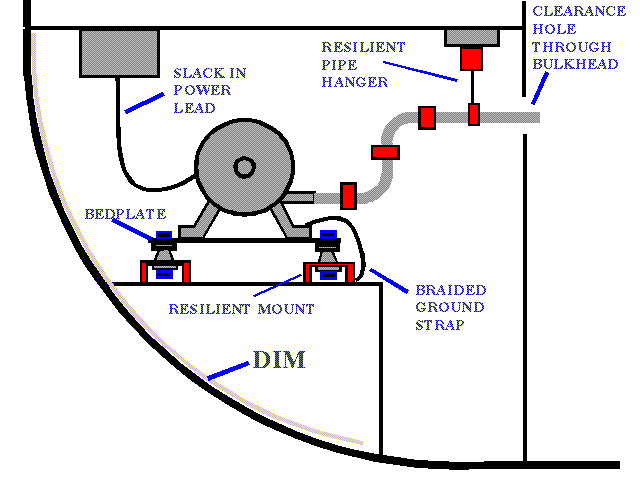
Figure 9.7-5 Typical Isolated System
4. The CHENG/ASWO should maintain a complete check-off list that identifies the noise isolated equipment, its location and work center responsibility.
5. Prairie-Masker System.
a. Prairie - injection of LP air through holes in the propeller blade tips. This fills the vacuum left by the rotating blades as the water "boils". Allows cavitation bubbles to contract more slowly as area of underpressure is minimized.
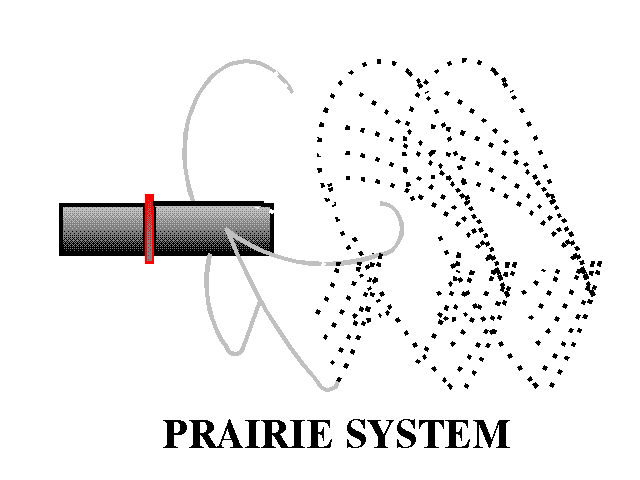
Figure 9.7-6 Prairie Air System
b. Masker - creates acoustic impedance mismatch between hull and water ,by way of the masker belts located around the hull, putting a blanket of air bubbles between the hull's machinery noise and the water.
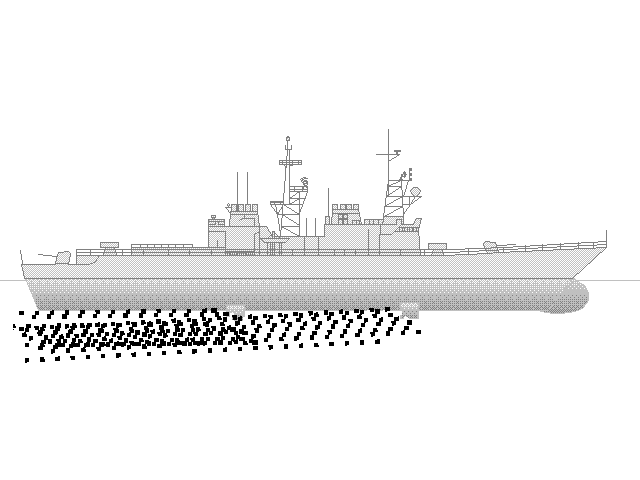
Figure 9.7-7 Masker Air System
c. Employment of Prairie-Masker.
(1) Guidelines are contained in respective TYCOM instructions.
(2) Prairie-Masker is used during both active and passive USW operations. Gas turbine ships will routinely operate systems inport and at sea, to avoid marine growth from plugging holes in blade tips and masker belts.
D. MONITORING PROGRAMS
1. Ship's force acoustical surveys are conducted on a continuing basis by shipboard personnel. Their purpose is to ensure that machinery is in top operating condition, noise control systems are effective and properly maintained, and no objectionable noise is generated by poorly stowed equipment. Ship's force surveys are made while the ship is at sea, moored, during upkeep and during overhaul. They should be conducted by the shipboard noise control team as a routine matter.
2. Housekeeping Survey (Readiness for Sea). The Housekeeping Survey is conducted to ensure that sound shorts are not installed, built-in, or created by repairs, alterations or stowage. The survey is also performed to locate the source of an acoustical problem noted during platform or radiated noise surveys. Equipment which is loosely stowed or improperly secured can be a serious source of noise in many ways. The motion of a ship at sea can cause loose items to move causing creaks, rattles, clanks and groans. The Housekeeping Survey is conducted before getting underway after completion of an upkeep period. Loose or unsecured locker doors and ladders must be secured. Clogged or obstructed ventilation ducts must be cleared. Sound shorts caused by improper stowage of items must be found and stopped. Missing sound isolation devices must be replaced.
3. Isolation System/Material Survey. The Isolation System Survey is conducted to ensure that sound isolation systems are effective and to initiate corrective action where they are not. The effectiveness of sound isolation systems may be completely nullified by improper installation, lack of proper maintenance, defective components or by sound shorts. Conducted on a semi-annual basis by noise control team. Inspect for proper installation, loading and maintenance of sound isolation devices. Pretty does not necessarily mean effective (don't paint over devices). Typical surveys include:
a. Sound absorption material survey - Distributed Isolation Material (DIM) inspection
b. Damping material survey - Resilient mounts, Pipe hangers and flexible couplings inspections
c. Airborne noise survey - Periodic measuring of ambient noise levels.
d. Topside noise survey - Measurement of equipment noise in the upper superstructure, which can short to the ship's hull.
4. Structure Borne Vibration Survey. The Structureborne Vibration Survey is conducted to detect and record changes from established shipboard machinery baseline vibration levels. The results of this survey are used to determine the acoustical and mechanical condition of the ship's machinery, and to identify those items which are potential platform radiated or self-noise problems.
5. Propeller Cavitation Noise Monitoring. Although measurement of this noise is part of external monitoring, internal monitoring procedures exist to measure the speed of cavitation inception. The relationship between operating speed of own ship and cavitation noise is an important factor is passive USW tactics. Cavitation noise increases with propeller operating time due to deterioration of the blades. Conducted during the first 24 hours following a lengthy inport period.
6. Sonar Self Noise Survey. Sonar self-noise surveys are conducted to determine the operating condition of the sonar at various ship's speeds. Any increase in noise level due to ship or machinery operation should show up in increased levels during specific types of operations as compared with levels obtained when the ship and sonar were in optimum operating condition. In essence, sonar self-noise surveys are made to determine whether a problem exists, and to provide sufficient information to define the problem and analyze it to determine the cause. Conducted IAW PMS and in conjunction with sonar source level and sensor receiver sensitivity tests. Required conditions include: water depth in excess of 600 feet; sea state 2 or less; an area free of shipping; an area free of strong tides or currents and noisy marine organisms.
7. IMA Underwater Hull Survey. Done while the ship is undergoing upkeep. These surveys serve as a constant check on the underwater portion of the hull, sonar dome and propellers to determine whether cleaning or repair is necessary. Completed in accordance with the 3M Maintenance Manual.
8. Shipyard Acoustical Survey. Acoustical surveys are conducted by the shipyard while the ship is under construction, prior to final delivery of the ship and throughout the life span of the ship during overhaul cycles. The purpose is to obtain qualitative and quantitative measurements of the acoustical condition of the hull and individual machinery in relation to the overall acoustic signature of the ship.
E. QUIET SHIP OPERATING PROCEDURES
1. SURFLANT/SURFPAC Quiet Ship Bills (QSB) vary slightly in format, but are identical in scope and nature. Each TYCOM quiet ship bill is detailed in their instructions.
2. QSBs represent the effective utilization of all noise control procedures by specifying operation of appropriate machinery at various speeds to maximize USW effectiveness.
3. QSBs emphasize best engineering plant line-up / machinery combinations.
a. Developed through comparison of self noise values in varying plant configurations.
b. All ship evolution; each department/division will participate and contribute.
4. By reducing the ship's radiated noise to a minimum, the ship's counterdetection range will be reduced to a minimum, thereby inhibiting an opposing submarine’s ability to acquire timely fire control information.
5. The reduction of radiated noise will also help to limit background noise, thus enhancing both passive and active acoustic sensors.
F. ADVERSE EFFECTS OF SHIP GENERATED NOISE
1. Ship generated noise, both self and radiated, has the following adverse effects:
a. Decreases own ship's sonar detection range.
b. Interferes with own ship's narrowband processing capabilities.
c. Increases counterdetection range.
d. Increases probability of being acquired by an acoustic homing torpedo.
e. Increases chances of own ship detonating an acoustic influence mine.